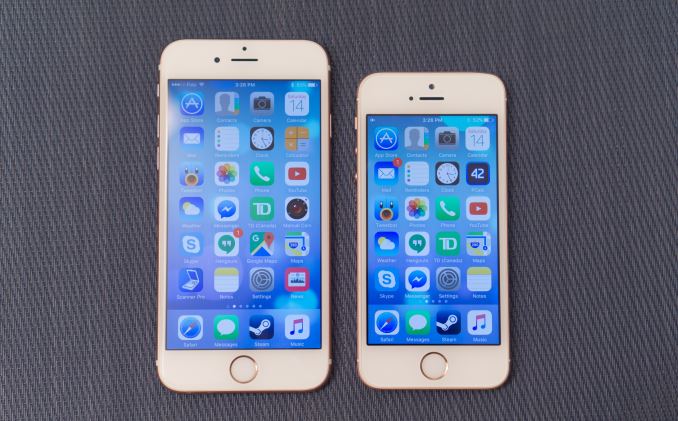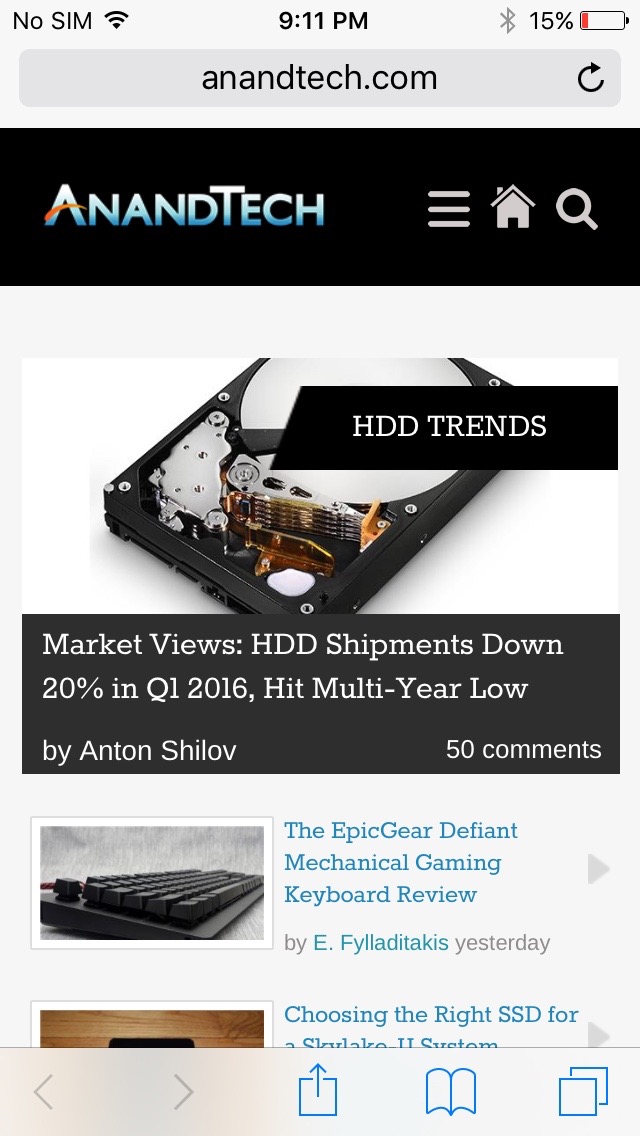The iPhone SE Review
by Brandon Chester on May 16, 2016 8:00 AM EST- Posted in
- Smartphones
- Apple
- Mobile
- iPhone
- iPhone SE
Going Back To A 4-Inch Smartphone
The Android world left the 4-inch smartphone behind long ago. While Apple was still playing the 3.5-inch smartphone game, Android phones moved from 4 inches, to 4.3 inches, to 4.5 inches, and so on. Nowadays, your standard Android flagship phone has a display that is a little over five inches in size, and a 4.5-inch display is what’s considered a tiny phone. Of course, there are other factors related to device size like whether you have physical or on-screen buttons and how large your bezel is, but the screen size is still what defines the limits of your window into the internet and all your applications. A couple of years ago I used the iPhone 5s, and nowadays I use the Nexus 5X and the iPhone 6s. Devices that really bring total device size up a notch like the Galaxy Note 5 and iPhone 6s Plus are simply far too large for me to use comfortably. Even with that, going back to a 4-inch smartphone definitely takes time to get used to, and it’s given me some interesting insights into what you gain and what you lose by moving to a larger device.
My first point about the iPhone SE seems patently obvious, but it’s really worth stating that when you move from a 5-inch smartphone to a 4-inch one it really feels small. I’ve actually been having some interesting thoughts on this subject as I’ve juggled between various iPads for the upcoming 9.7-inch iPad Pro review. If you use the iPad Mini for a long time, a 9.7-inch iPad feels absolutely enormous by comparison. Similarly, when you use the 12.9-inch iPad Pro for a long time, the 9.7-inch iPad feels like an iPad Mini in comparison, and the Mini itself feels absurdly small. In all these cases there’s an adjustment period where one has to get used to the size of the device, and after that time passes it becomes your reference point for what is normal.
I don’t expect that too many users will actually go through this adjustment period if they buy the iPhone SE, as I would imagine that many prospective buyers are people who are still holding on to their iPhone 5 or 5s and have been hoping for an updated 4-inch iPhone. After getting used to the SE, I’ve found myself enjoying the one-handed usability. Say what you will about features like reachability and one-handed modes; the 4-inch screen is simply much easier to use with one hand. I never worry about dropping the phone, and I don’t find myself having to shift my hand to reach the upper left area of the display.
On the flip side, the 4-inch form can feel quite cramped, even after adjusting to the smaller display size. With the default settings the information density is absolutely laughable, and I can’t use the phone without the text size setting set to the smallest value. I use the smallest text size on all my devices, but for users who need a larger font due to aging eyes I would honestly rule out the iPhone SE immediately unless you’re comfortable with doing a lot of scrolling. Even with that changed, you simply can’t fit near as much on the screen. You get one fewer row of home screen icons, fewer emails in the Mail app, no avatars in the Messages app, and similar reductions throughout the rest of Apple’s apps as well as third party ones. Features like Control Center which just goes past the halfway point on the 6s takes up nearly the entire screen, and it makes me wonder how it ever even fit on the 3.5-inch iPhones.
All of these changes are just a function of the display size, and while they seem obvious, it’s difficult to understand the extent to which they change the experience of using the phone. While I’m not someone who is sold on phablets, I certainly see the value in them for many people, and for me the sweet spot is something in the 4.5 to 4.7-inch range. I’ve used the iPhone SE as my primary device for a month now to see how it works for me, and when I returned to the Nexus 5X and iPhone 6s they both felt absolutely enormous. However, I find myself really valuing the additional information that I can see in the larger display while still having the phones be relatively usable with a single hand. The 4-inch screen isn’t the right size for me, but I recognize the benefits of it. With Apple having sold 30 million 4-inch smartphones last year despite the fact that their offering was a phone from 2013, there’s clearly a market for such a device, and I think the iPhone SE will make those users quite happy.













138 Comments
View All Comments
michael2k - Tuesday, May 17, 2016 - link
What exactly did you want to see? S7 is slightly slower than the iPhone SE in CPU, slower NAND, slightly faster in GPU offscreen, slightly slower in GPU onscreen (due to larger and higher resolution screen), several hundred dollars more, and about the same battery life.http://www.anandtech.com/show/10120/the-samsung-ga...
Che - Wednesday, May 18, 2016 - link
I want to read reviews for the various android phones released this year. I am not in the market for an iPhone, personal preference.I think you missed my point.
michael2k - Friday, May 20, 2016 - link
I did, sorry. When you said 'lack of review of Galaxy S7' I had misinterpreted your comment as a complaint that they didn't compare the SE to the S7.jav_eee - Tuesday, May 17, 2016 - link
The only part I disagree with is where you mention that the 6 feels better in the hand. I don't think it does. It is much too slippery. The 5 was perfect.Silvio6 - Tuesday, May 17, 2016 - link
This looks like the benchmarks were extracted from a tool, and not realy real-life tests. For example, i was told the fingerprint sensor was slower than the one from the 6 and 6s. How much slower ? The one in the 6 is acceptable, but i wish there was the one in the 6s. There is no mention of it in the tests, and this is something anyone would be confronted to multiple times a day.bodonnell - Wednesday, May 18, 2016 - link
It is slower than the 6s, but at worst it should perform similar to Touch ID in the 6 as both use the 1st gen sensor. In practice it may be slightly faster than the 6 as the A9 chip processes the unlock faster than the A8 in the 6.heartinpiece - Tuesday, May 17, 2016 - link
For the NAND tests are the read/writes to NAND encrypted?I'm guessing some of the other compared devices are not encrypted... Could you elaborate, or distinguish the encrypted from unencrypted devices?
Brandon Chester - Tuesday, May 17, 2016 - link
In mobile if a device is encrypted then you're usually stuck with that, so I don't see any point in differentiating. In the end we're still comparing devices as they work within the limitations of their hardware and software, not the hardware components individually.gochichi - Wednesday, May 18, 2016 - link
I'm really happy with the Nexus 5X, including the great price, camera, 32GB option, etc. I'm a happy camper.Nick Arthur - Wednesday, May 18, 2016 - link
It seems a transitional version between 5 and 6 but combines some advantages of the two version together. The price is much cheaper, exactly.